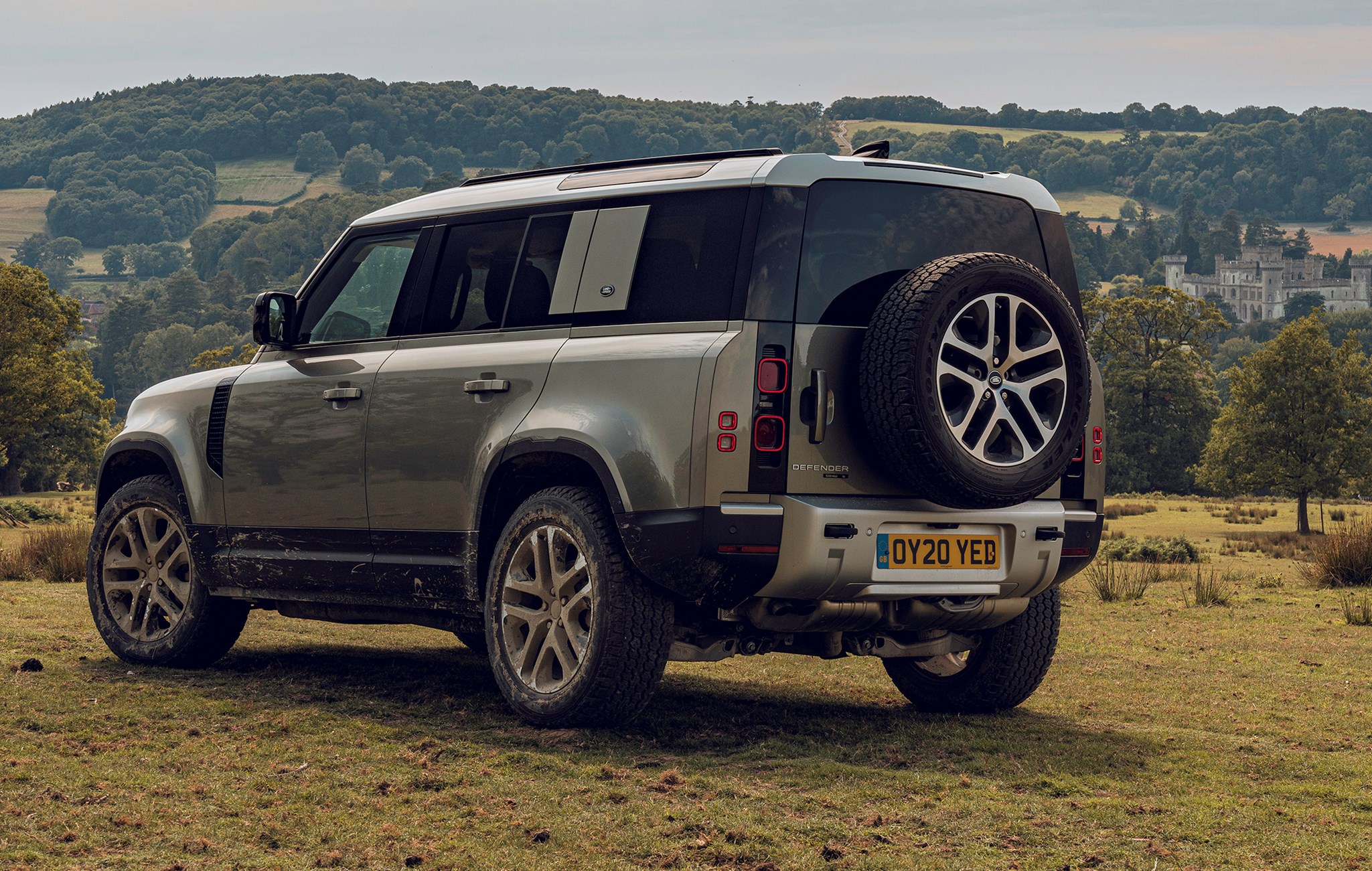► Defender 90, 110, and 130 reviewed
► Capable 4x4s, brilliant on- and off-road
► Good enough for Defender diehards?
The question isn’t whether the new Land Rover Defender is a good car, or even whether it’s as capable off-road as you’d hope. Those things are important, yes. But what really matters is whether this new SUV has the chops to replace one of the 20th century’s most iconic vehicles. And the answer is… complicated.
The new Defender had almost as fraught a beginning as the original. A matter of days before the world’s media were handed the keys to one of the most important new vehicles in yonks, the globe went into lockdown. The frustration at the firm’s HQ in Coventry must’ve been palpable, having gone to such lengths to produce one of its most critical products in generation only for a health pandemic to muffle its launch.
Skip ahead to the second half of 2020 and Defender sales begun to ramp up, with long-anticipated first drives for the Defender 90 and Defender 110 variants finally taking place. We’ve now driven the whole range – the 90 and 110, diesel, V8 and plug-in hybrid, a mild-hybrid most recently the massive Defender 130 – including a stint thrashing the LWB Defender across a desert (see video above).
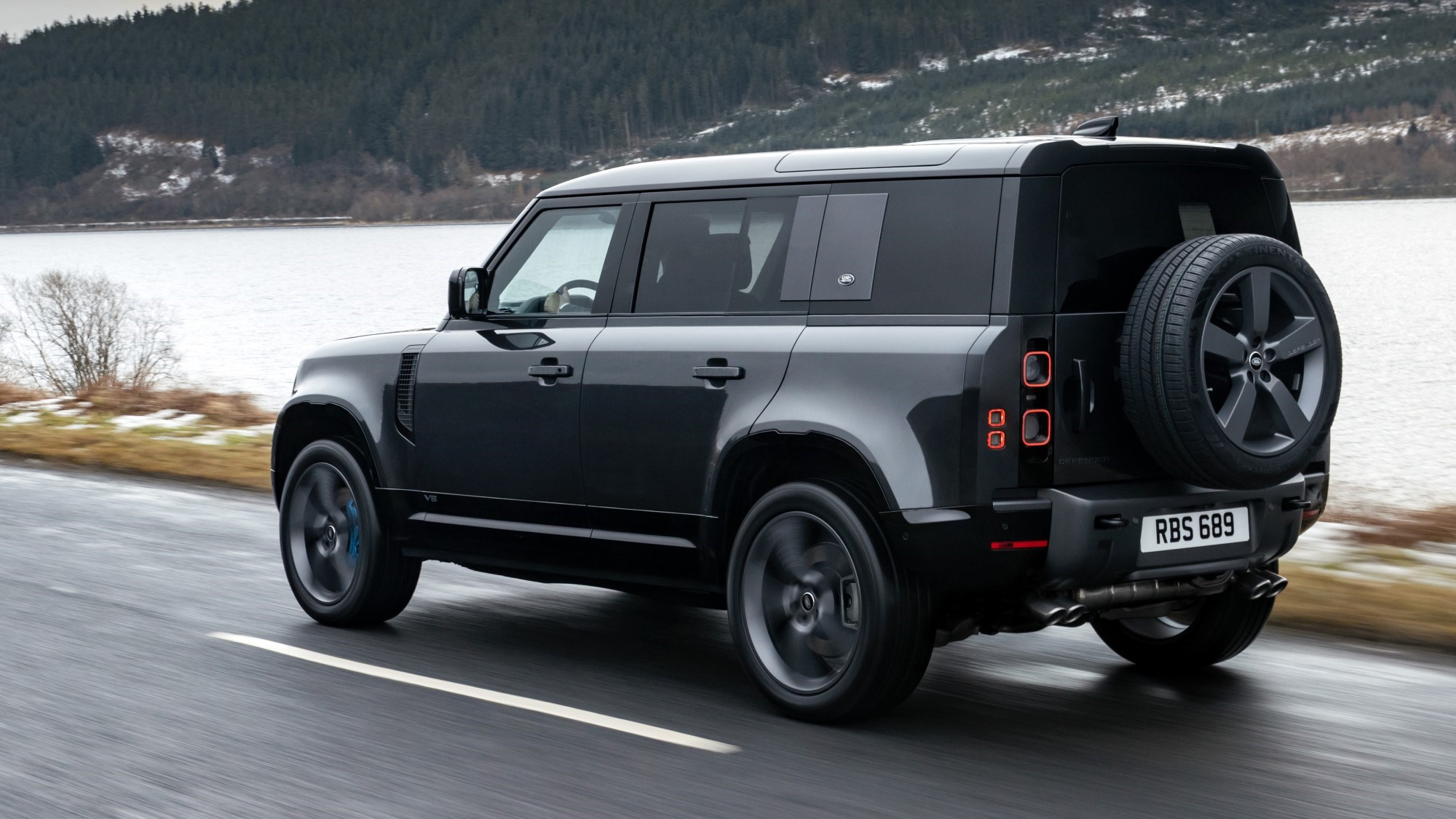
Here’s the snap judgement of our Land Rover Defender review: the company has succeeded in giving the Defender a new lease of life, with on-road abilities that don’t compromise the car’s astounding performance away from the asphalt. It effectively had two briefs and it nailed both of them, more than living up to that imposing legacy.
The next question is whether this latest version has real Defender DNA, and whether it’s a still a proper alternative to other hardcore off-roading rivals, including the Jeep Wrangler, Mercedes-Benz G-Class and Toyota Land Cruiser. Keep reading our Land Rover Defender review for the full verdict…
What you need to know about the 2023 Land Rover Defender
Before we delve too deeply into how it drives, it’s worth catching up on a little on the technology. ‘Project L663’ is based on JLR’s D7 Premium Lightweight Architecture (PLA) aluminium platform – but it’s been developed into the D7X (X for Extreme) monocoque, which is claimed to be three times stiffer in terms of structural rigidity than its rivals.
In real terms, that means the Defender should withstand serious loadings – reflected in its off-road ability and on-road poise.
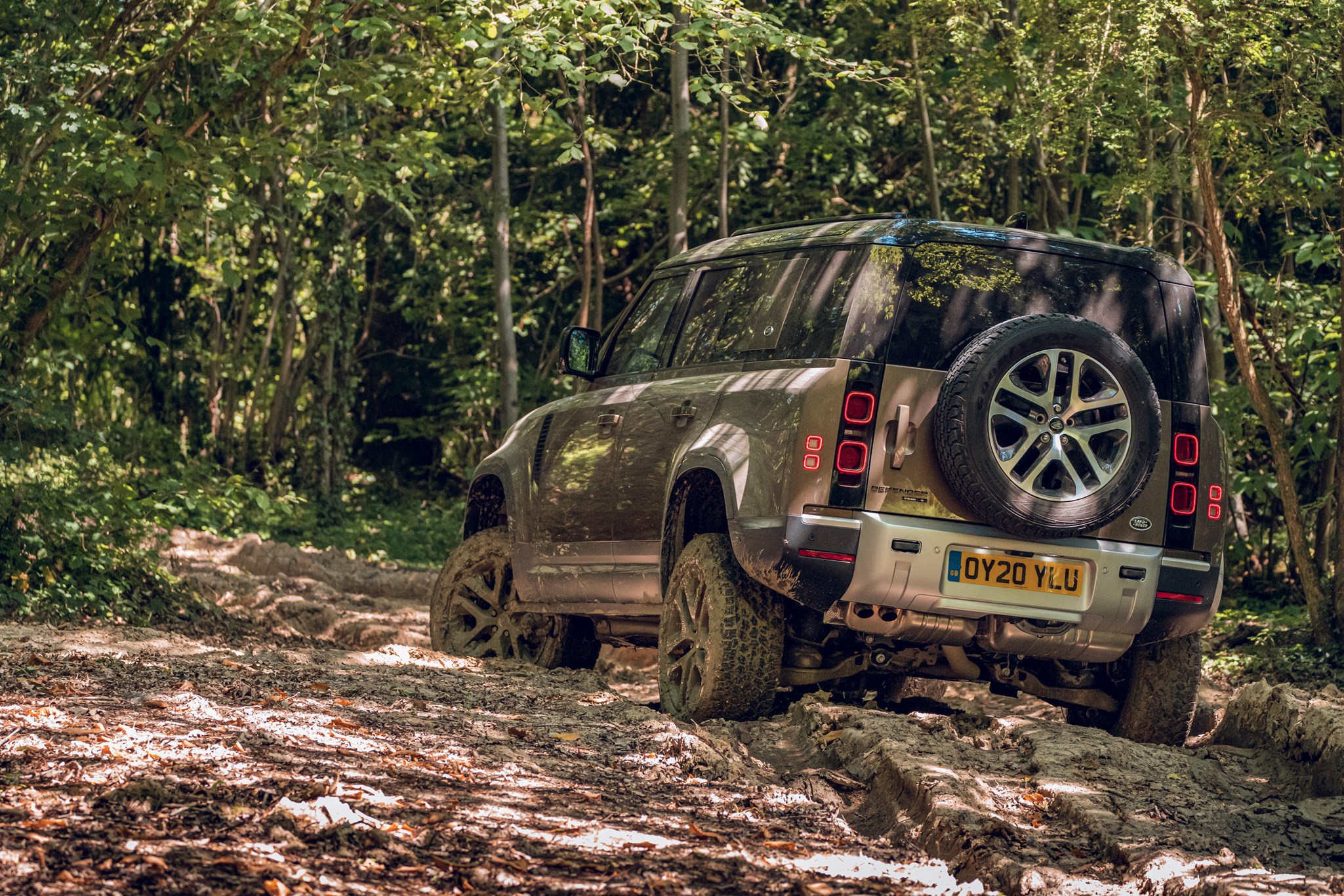
It has serious off-roading covered. Approach angles are 38 degrees front and 40deg rear, providing it’s specced with air suspension, and it can climb a 38-degree angle and descend a 40-degree one (again on air springs). Wading depth is up to 900mm deep, compared with 500mm for the old Defender, while the electrical system is tested to IP67 standard – they should be able to be submerged in water for up to an hour without damage.
Off-road, the only notable difference between the short 90 and longer 110 is that the former has a ramp breakover angle of 31 degrees, but the latter’s extended wheelbase reduces its figure down to 28 degrees. Still impressive, nonetheless.
There’s bags of tech, too, as you’d expect. Land Rover’s latest electronic architecture is significantly faster than before and now features such delights as over-the-air software updates, plus an infotainment system that’s swift and responsive to use. It has 85 ECUs, and they’re constantly talking to each other at up to 100Mb/s – a major step forward.
If you want a Defender, you’re looking at a wait of a few months (especially now that the semiconductor chip shortage has gripped the industry), particularly if you’ve gone for the dinky 90 or been choosy with the configurator. That’s taken as read when you consider there’s the base-spec Defender, X-Dynamic, XS Edition, X, V8 and V8 Carpathian Edition, each of which can be specced with S, SE or HSE specification packs.
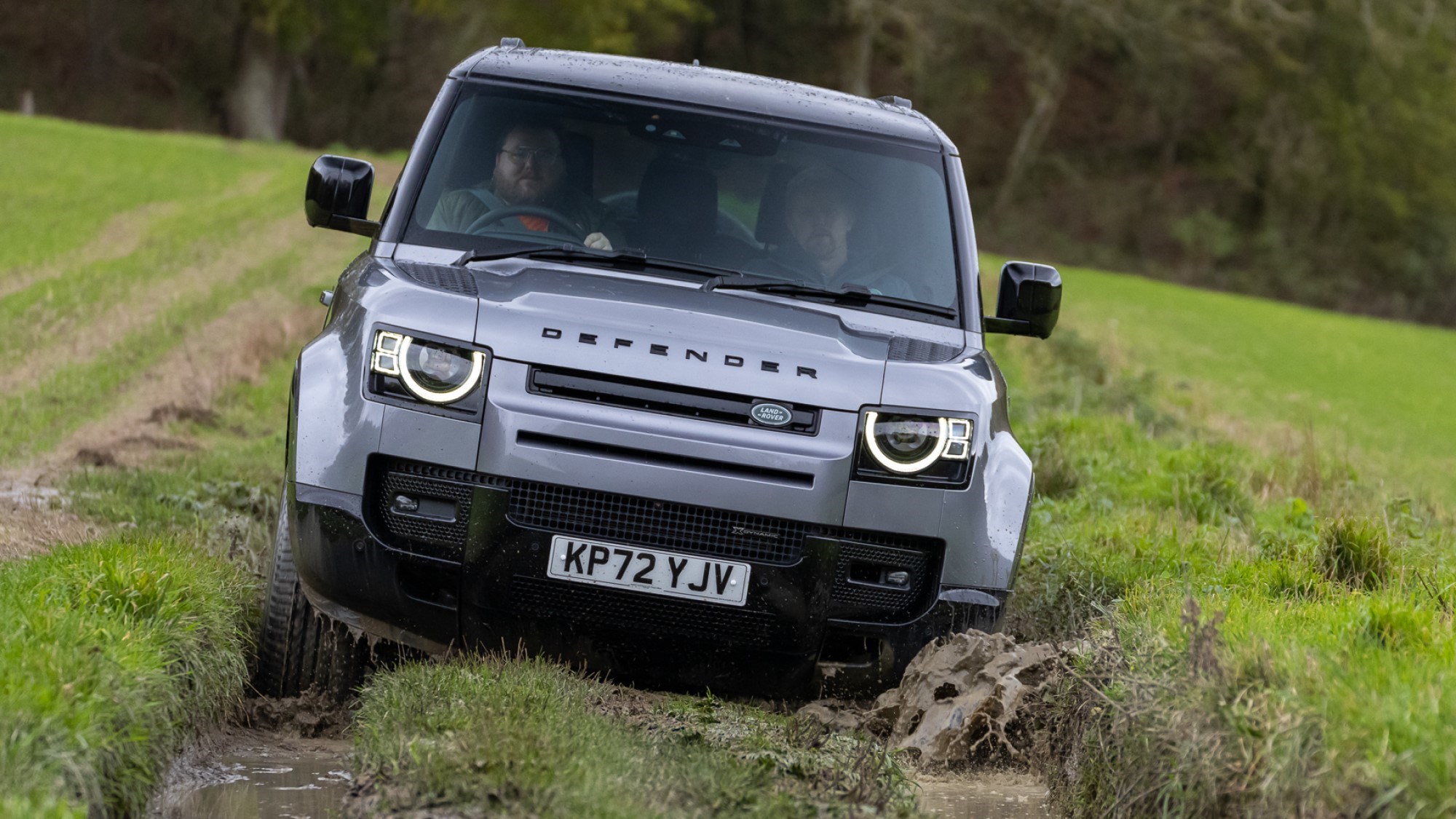
Additionally, you can choose between a mild-hybrid 3.0-litre six-cylinder diesel with of varying outputs (replacing the original 2.0-litre four-pot), a 2.0-litre petrol, a 3.0-litre, six-cylinder petrol also with MHEV, plus the plug-in hybrid P400e, which also utilises the 2.0-litre mill. To cap it all off, those V8 Defender editions get a 5.0-litre V8 supercharged petrol developing 518bhp. All are driven through an eight-speed ZF automatic transmission and dual-range 4×4. As well as that, there’s an unending options list to truly personalise your Landie. Exhausting.
What’s it like inside?
Inside, the Defender mixes elements of the original’s functionality with the tech and equipment you expect of a modern car. There are exposed screw heads and ruggedised surfaces on the one hand, classy-looking aluminium panels on the other. It’s a well-judged mix and, if anything, is a more successful new-age reboot of the franchise than the exterior. We’d fight shy of calling it premium, but it has an aura of quality with a dash of toughness. That strikes the correct balance.
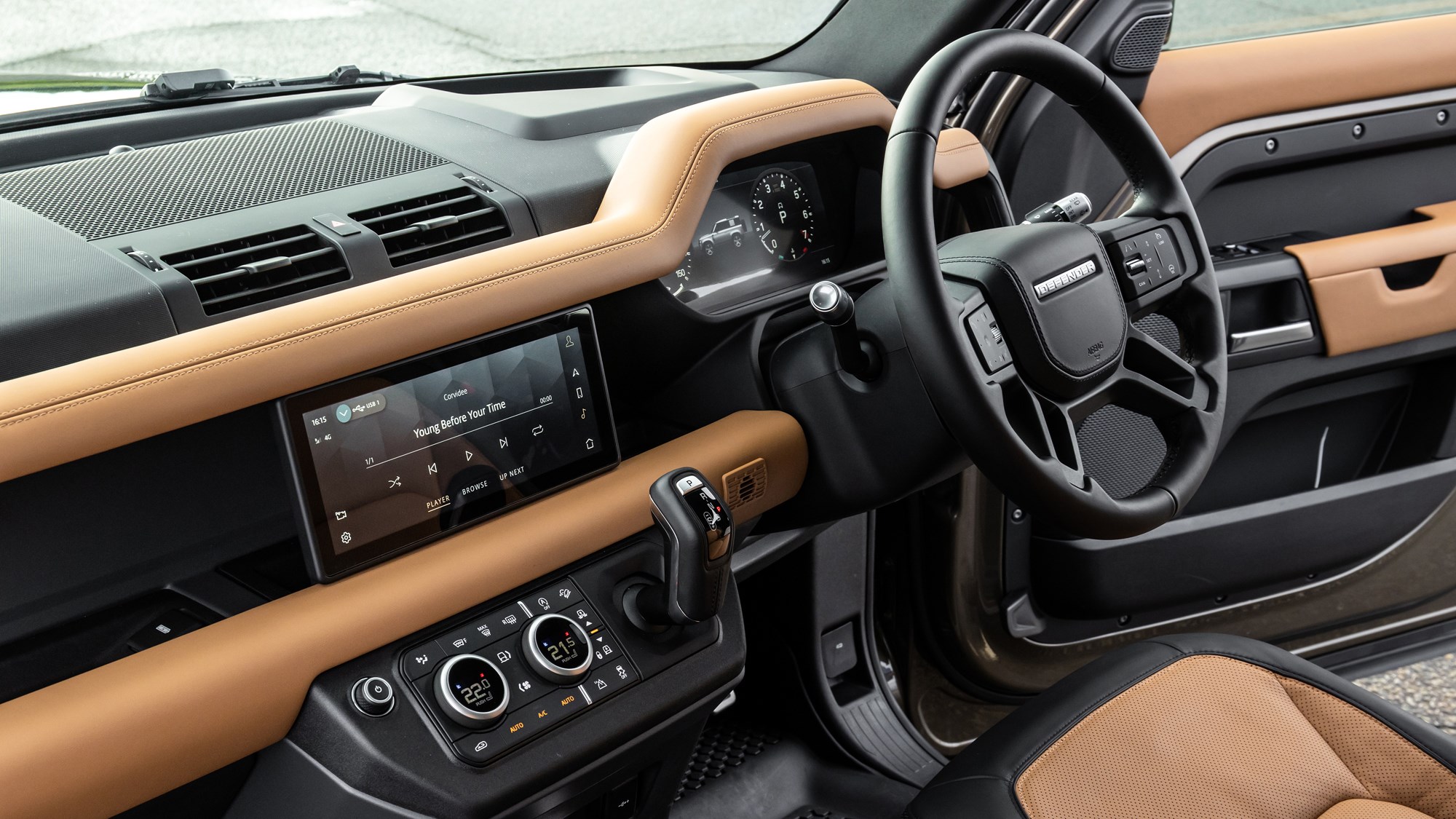
There are some very un-Defender-like touches now, such as padded armrests and a smattering of soft-feel surfaces, as well as the joy of that optional central front seat, which you can have in place of a very capacious central storage area and cupholders. There are storage areas everywhere inside, with deep door pockets and a dashboard shelf that’ll take most of your gear on the move.
The new Pivi Pro infotainment system is a cinch to use, being both quick and intuitive. It also syncs up and works with your smartphone seamlessly, too. No more wrestling with it to get Apple CarPlay or Android Auto to work. Other nice touches are the ClearSight rear-view mirror for when your Defender is loaded to the roof – or you want to see what your spare wheel’s obscuring – and the ClearSight camera set-up that allows you to virtually see through the bonnet via the infotainment screen for super-tough off-roading sessions.
In short, it’ll be great for expeditions and is completely family-friendly, in 110-guise at least. The ruggedised interior should shrug off anything the kids throw at it, and while it’s short of being hose-clean inside, the longer Defender has a boot that’ll swallow a couple of sheep. Boot space goes from 231 litres with all three rows in place to 2233 litres with all the seats folded for the 110, 397 to 1563 litres in the compact 90.
Opt for the huge 130 and you’ll get the most capacious vehicle this side of a minivan. Three rows of seats for a total of eight, with adult-sized legroom in each makes it somewhat unique. The third row’s a little too narrow for three adults to sit comfortably, but you still get a good view out with large windows and a standard panoramic roof. Boot space starts at 389 litres and goes up to a mammoth 2,291 with both rear rows folded down. Oh, and you get five Isofix points should you be a particularly prolific breeder.
What’s it like to drive?
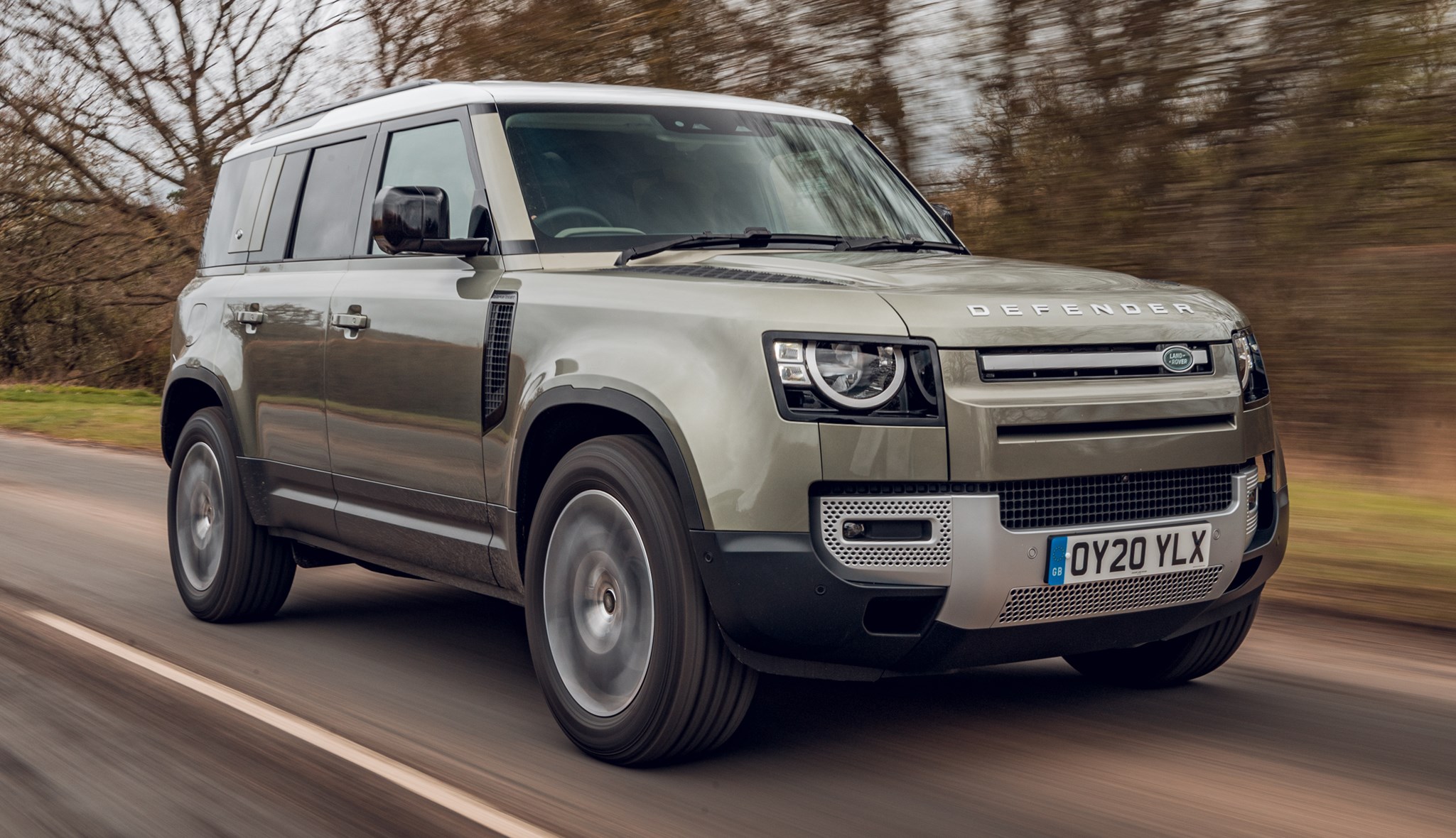
Initially we drove a Defender 110 D240, a model that’s been discontinued for 2021, replaced by the D250. Being the more powerful of the two diesels originally on offer, there was little wrong with the way it went – developing 237bhp and 317lb ft – going a long way to overcoming its hefty 2248kg kerb weight. On paper that translates to a 0-62mph time of 9.1 seconds and a maximum speed of 117mph – but on the road, it’s more than adequate.
That’s the tedious issue of performance figures out of the way – but how does it actually feel on the road? A bit of a revelation, actually. The first thing that surprises is the agility of the thing, and although it’s self-evidently no sports car, direct and well-weighted steering give it a positive relationship with the road, while the air suspension fitted to this model gives it a compliant ride and excellent body control. Okay, it could be argued that this shouldn’t be a Defender priority, but we’re in a new world now, packed with car-based SUVs pretending to be off-roaders, and the Defender will need to swim in that pool to satisfy its owners.
Beyond that, it corners with an accuracy that will surprise you. It’s easy to place, tracks bends faithfully, and we’d go as far to say that if the road is reasonably sized, it’s an enjoyable steer. Sadly, our first drive took place in the Cotswolds where the roads are cramped and packed, so we couldn’t really explore too much – but it did emphasise how confidently you can place the Defender when the going gets tight.
At speed it’s restful enough – there’s not too much wind noise to concern yourself with, it doesn’t seem to be affected by crosswinds, and the Ingenium diesel is hushed and responsive. In all, a very impressive effort, leaving us with only one question – why would you buy a full-sized Land Rover Discovery now?
What about the Defender 90?
Our on-road drive of the shorter 90 revolved around the potent P400 model, available exclusively in range-topping X specification (V8 models aside). It weighs in at £86,265 – you have to be a committed worshiper at the church of Land Rover to not question that price tag. Leaps of faith aside, you’re treated to the more refined, throatier soundtrack of a 3.0-litre straight six version of the Ingenium powertrain, complete with mild-hybridisation.
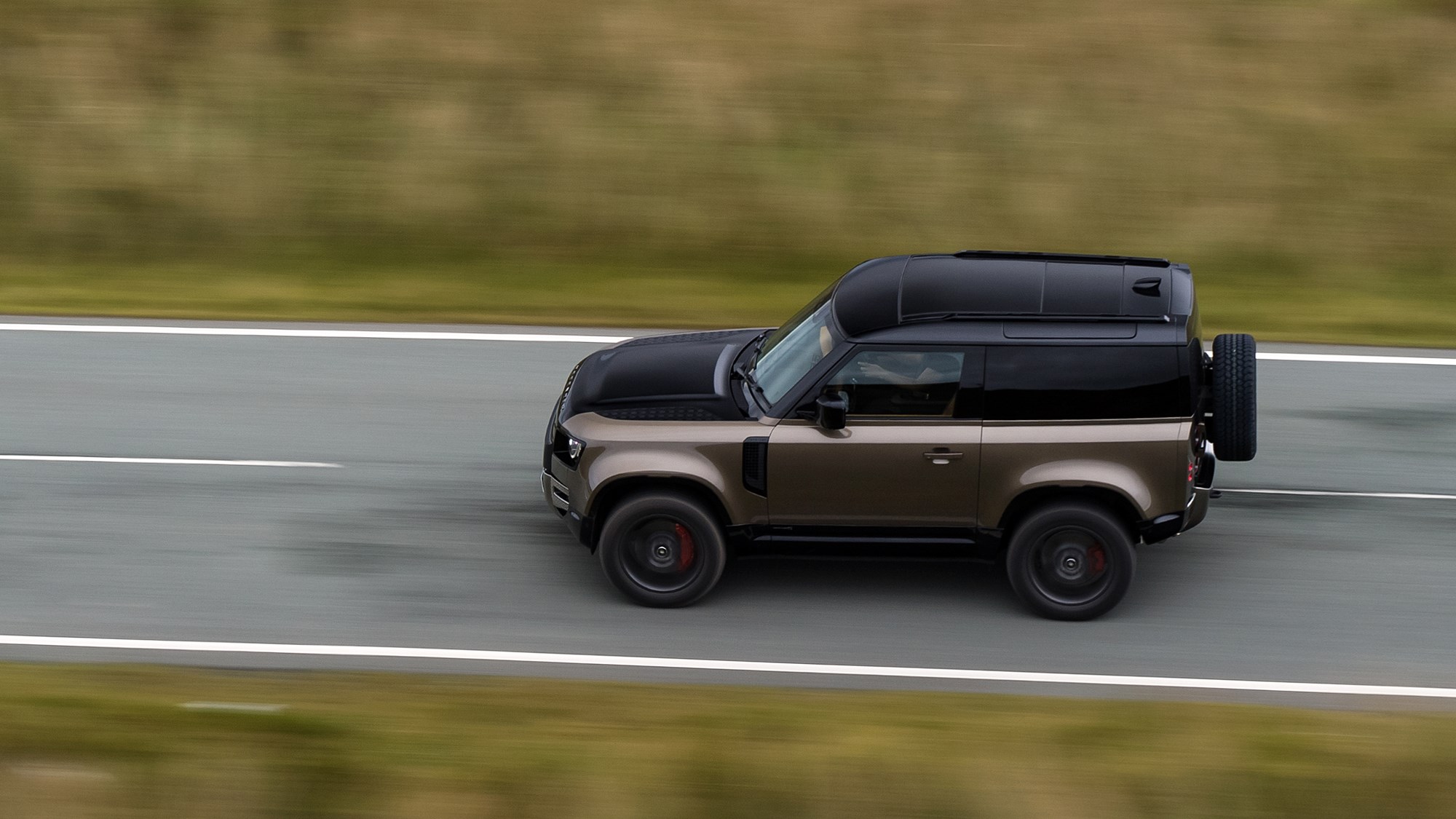
It’s a very effective integration, proving seamless at slow speeds, being keen to cut the engine out as soon as possible when you’re slowing for traffic lights and junctions, but more impressive is the torque surge that pushes you along when you’re more liberal with the throttle application. Land Rover’s figures claim that squirting from 50-75mph takes just 3.6 seconds, while the anachronistic dash from standstill to 62mph requires just 6.1 seconds. Remember, this is a Defender, and in this spec weighs 2268kg.
Despite its heft, tall body and short length, it handles nimbly, not feeling appreciably different on-road to the 110, although the air springs and on-board electronics doubtless dial out any twitchiness that the shorter wheelbase might otherwise introduce. Whether it’s psychological or not, because you can’t help but notice how short it is from the commanding driver’s seat, you feel more inclined to hurl it about with vim on windy B-roads. It’s a hoot doing so, or at least it is when the gap between the hedgerows is wide enough for you and a Transit van to pass each other without sucking copious volumes of air in through your teeth.
We have separate reviews of the V8 and PHEV models.
What’s the Defender 130 like?
The 130 is unlikely to be offered with the V8 or PHEV powertrains, so for the moment it’s the mild hybrid P300, P400 and D300 offerings. The D300 we drove makes by far the most sense – it’s torquey, rapid enough (at least unladen) and though fuel consumption is unlikely to escape the high 20s it’s still better than the petrols could dream of.
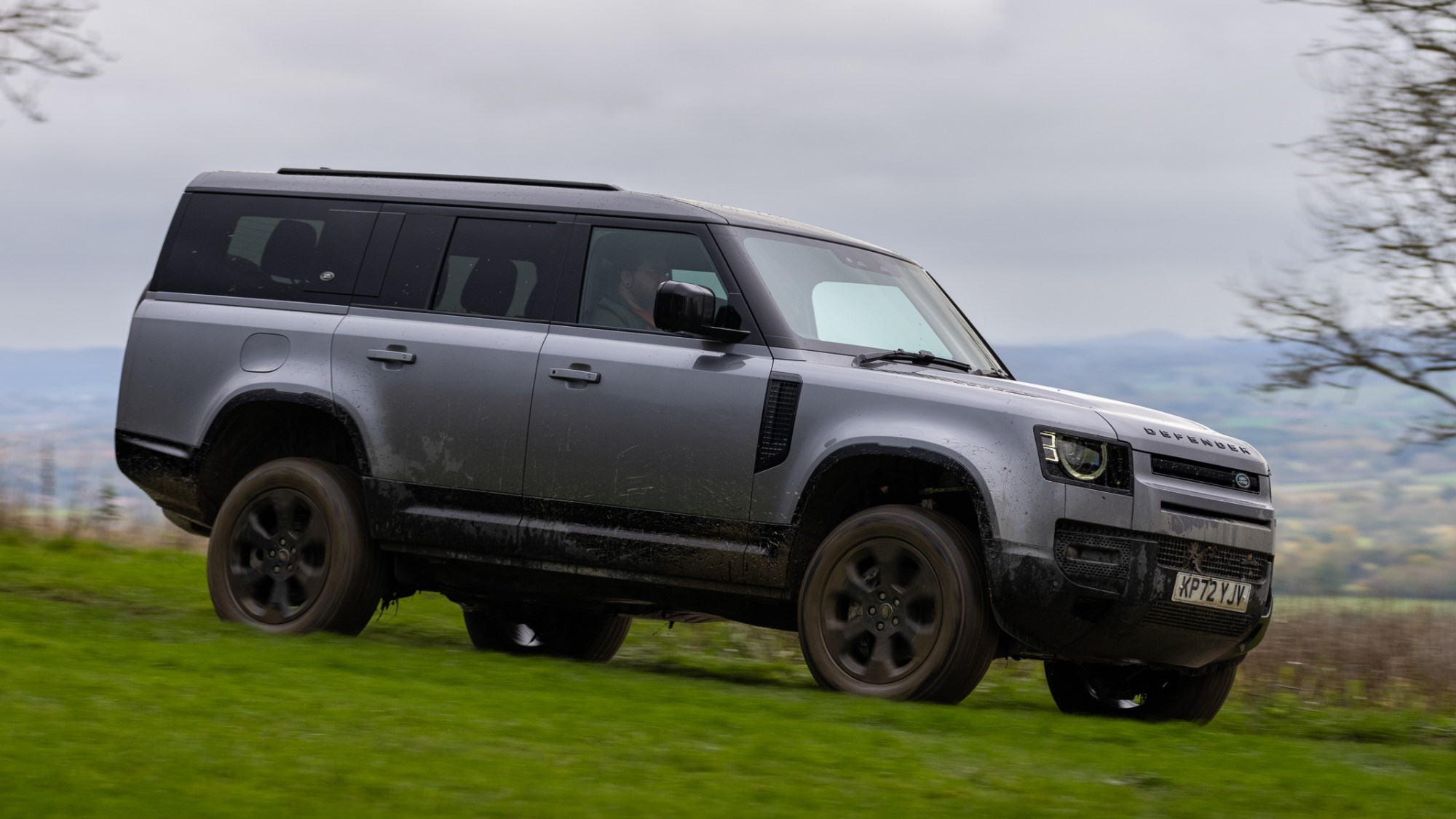
Compared with the 110 you notice very little change in the car’s manners – the standard air suspension does a good job of masking the additional weight, only being noticeably firmer at low speed. Otherwise, ride and body control is as impressive as its two smaller siblings. We’ll update this when we know what it’s like to drive fully laden, though – even allowing for relatively slim passengers, eight of them means an additional half ton of weight…
What’s it like off road?
We’ve tested the Defender at Eastnor Castle, the home of Land Rover off-road development since the original Series model in the lead-up to its launch in 1948. The place is steeped in LR history, and as you’d expect, it was always going to perform strongly on its home turf. Full disclosure: running was conducted on all-purpose tyres and on courses purpose-built by the firm’s engineers, which looked impressive, gave it a decent work-out, and consisted of rutted, muddy tracks, steep, slippery inclines, and the stickiest of mud.
The toys are all there – height-adjustable air suspension (on the 110), low-range transmission, locking centre and active rear locking diffs, all mated to the company’s well-proven Terrain Response and Hill Descent technology. What this means is that Land Rover says it’s more effective than any other LR product and should prove near unstoppable in the English countryside.
And so it proves. Toggle Terrain Response and Hill Descent and then just steer and go. The Defender’s electronics and hardware make expert off-road adventurers out of the most hamfisted drivers. The steering, throttle and visibility leave you feeling confident that you can get from one end of the Darrien Gap to the other without real hardship – although Eastnor, we guess, could flatter to deceive. A proper off-road test will no doubt confirm our suspicions that this will live up to the Land Rover strapline, ‘Best 4x4xFar’.
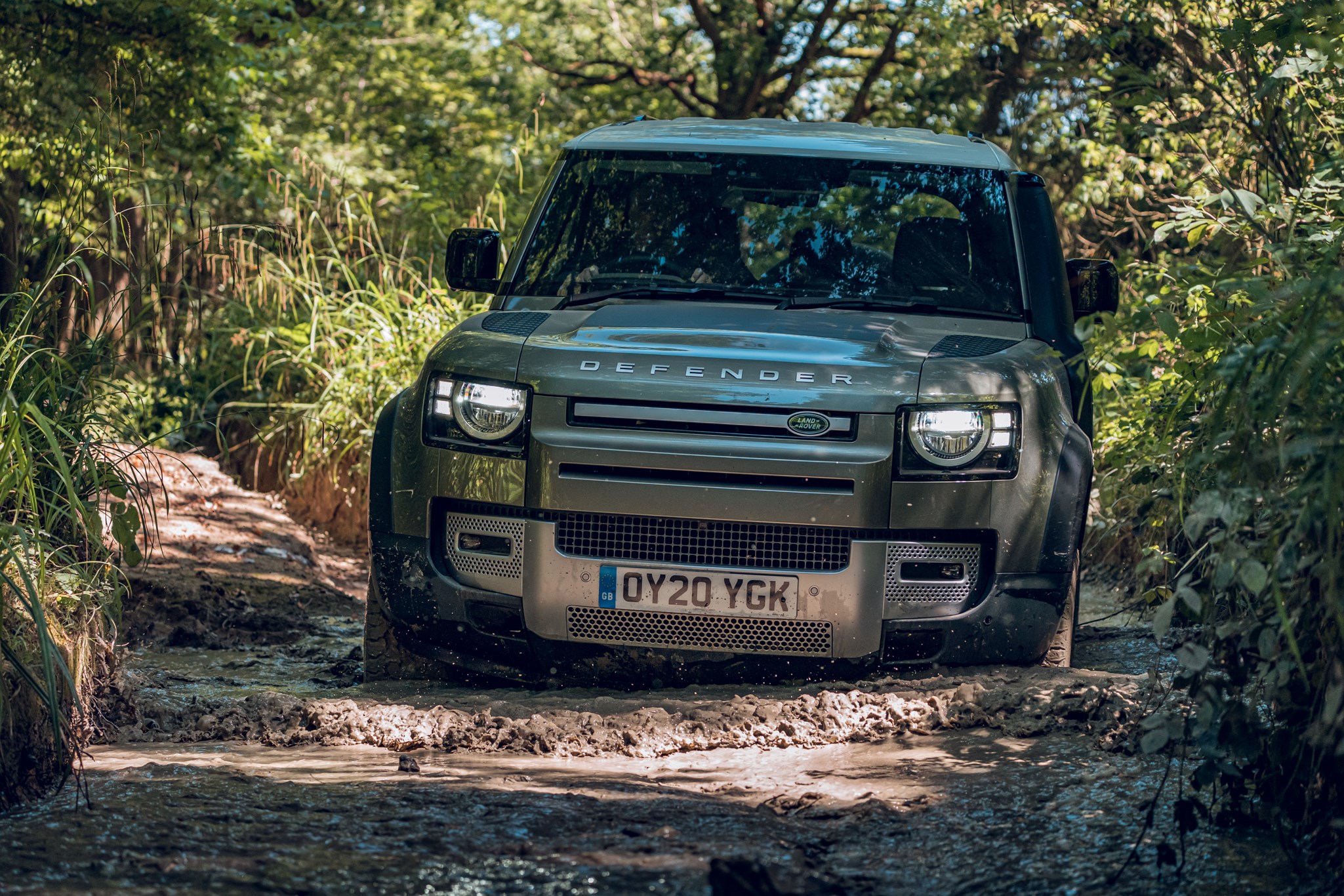
If you’re serious about your off-road driving then the air-sprung arrangement really should be the first option box you tick, but it’s demonstrative of Land Rover’s belief in the Defender’s abilities that when we drove the 90 on a similarly challenging course after nigh-on a fortnight of rain, we did so on the standard coil springs.
Most obvious difference between the two is that much more of the jolting from the deeply scarred trail tracks beneath are transmitted to the cabin, plus there’s no option to elevate the ride height up to the air-equipped model’s 291mm height where the going gets really tough, but over the course of two hours, any progress for the Defender 90 was only limited by traction in the mud – even then it got out under its own steam, without the need to be winched to safety.
Where the 90 proves slightly more adept over the 110 is that nimbleness you sense on the road comes to the fore off of it, wriggling around tree stumps, boulders and earth banks with impish ease.
If you’d like more confirmation of its off-road prowess, scroll down to read Gavin Green’s off-road adventure in a Defender in Namibia.
Verdict
So, the new Defenders are good. Not just in the countryside, but in towns and cities and on the roads that criss-cross our land. As a car to take on adventures, it certainly seems tough enough, and its off-road ability is peerless at this price point. Land Rover would never live it down if it were any other way. But most importantly, and for the toughest test of all – working out for the family – it passes with flying colours, offering space, tech and cool appeal to work on so many levels.
What it does that no Defender before has managed is to work so comprehensively well on the road. It sits comfortably on the motorway, it is playful on B-roads, and is happy in town. Specify it on air suspension, and you’re invited to a world of comfort that’s alien to previous examples of the breed, while ticking the 246bhp D250 diesel box on the configurator makes it accelerate effortlessly. Not bad for the mid-range power unit.
The only thing left to do is answer the question posed at the beginning: is this worthy of the Defender badge? Based on its Swiss Army Knife approach to everything life could throw at it, the answer surely is yes – as a tough off-roader that can turn itself to anything, it really is brimming with Land Rover DNA.
But is it the vehicle that so many Land Rover Defender enthusiasts ached for? Possibly not – the affordable, rugged workhorse of old, patched together with binder twine and usually with a pair of shouty Border Collies in the back is now the stuff of legend. For those of you who don’t live in the countryside, here’s a newsflash: Land Rover abandoned that market years ago, leaving the working replacement for so many beloved Defenders a battered Ford Ranger or Mitsubishi L200.
It’s now time to move decisively on to the next chapter of the Defender story.
So, 90, 110, or 130? Reality is that the 110 model makes the most sense for family life, with seven seats over three rows, a useful flat boot floor when the rearmost rows are folded away, it’s easier to live with – and doubtless to sell on. The 90’s more of a status car – all the more charming in its appeal as a result and will doubtless look particularly on point outside a chic London address – but the 110’s more rounded.
The 130’s more of a niche offering but the blend of comfort and space is quite remarkable. It’d make an excellent posh people-carrier for those who need space for adults in all three rows – effectively nuking the Discovery’s key selling point. Otherwise, it’s much the same as its smaller siblings and very impressive for it.
